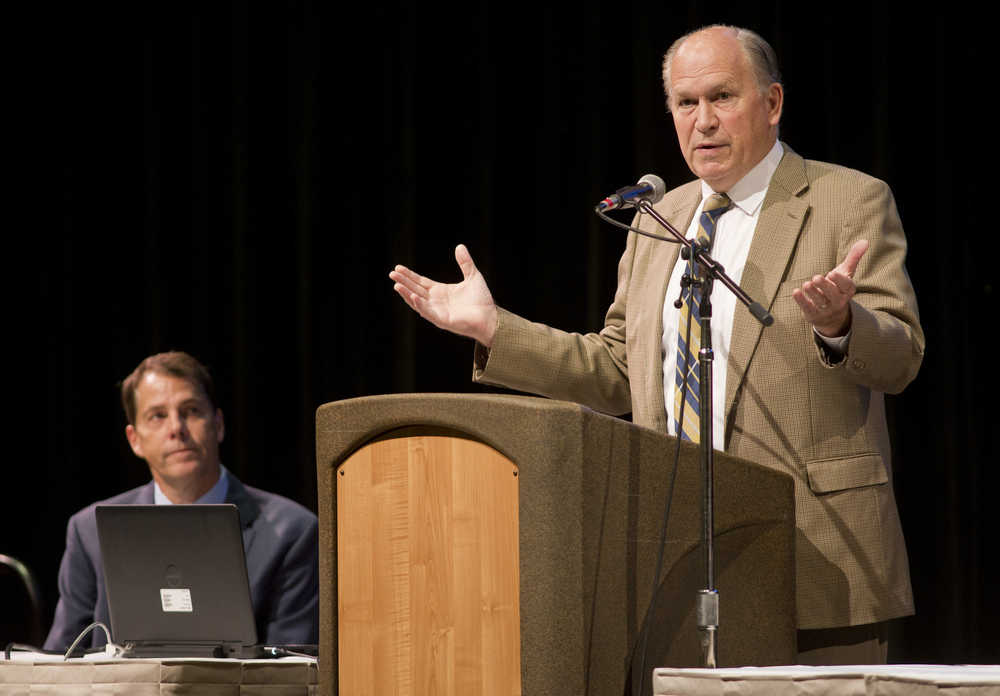JUNEAU — You can grow a 20-pound cucumber in Soldotna, but pay $5.79 for a one-pound bag of imported carrots in Kotzebue.
When it comes to fruits and vegetables, Alaska varies region by region. Areas like the Matanuska-Susitna Borough and Tanana Valley are great for growing, where outside farming in Arctic communities just isn’t a possibility. Some communities have regularly occurring farmers markets, while others are lucky to have fresh produce stocked in the grocery store at all.
“When we became a state, we used to raise half the food that was consumed in Alaska,” Gov. Bill Walker said Sept. 8 during the opening session of the National Association of Farmer’s Market Nutrition Programs conference in Juneau.
Now, that figure is at 4 percent.
“That’s partly because we have grown since statehood in population, but also we’ve sort of lost our vision a bit. We got a little too wedded to one nonrenewable commodity — oil — and we sort of stopped doing what we should have been doing,” he continued.
With 96 percent of the state’s food imported, Alaska only has three to five days of food supply, said Kathleen Wayne, the state’s director for the Special Supplemental Nutrition program for Women, Infants and Children, and manager of Family Nutrition Programs.
“I certainly know when I go to the local grocery store here and the barge hasn’t come in, there’s nothing on the shelves, and that’s Juneau. How about all those other remote areas around the state that we know don’t have roads that are reliant on planes or boats getting food to those areas?” Wayne said to the conference audience.
At the grocery store in the Aleutian community of Sand Point, she said, a cantaloupe costs around $8.29 and a pound of grapes costs $6.49.
Alaska faces many challenges when it comes to growing, including expense, microclimates, a short growing season, permafrost, soil low in natural fertility, cold soil or excessive rain.
At the same time, though, “We do have an abundance of Mother Nature’s fruits and vegetables that we all love,” Wayne said. She listed off foods like salmonberries, blueberries, beach asparagus and fiddlehead ferns.
Some people are getting around growing challenges through innovation. In Kotzebue, Arctic Greens, a subsidiary of the local Native association, is growing spinach, kale and other types of lettuce inside shipping containers. The plan is to supply local and nearby grocery stores.
Walker said he hopes to see ideas like that spur more Alaska-grown food.
“We spend $2 billion a year on food. We don’t have to go out and look to a market; we are the market. We just have to do what we do differently,” he said.
Wherever he travels in Alaska, Walker said he looks out for farmers markets. While he was recently at one in Fairbanks, he was handed a flier.
“It said, ‘If every Alaskan spent $5 a week on local produce, that would bring in $188 million,’ which is pretty phenomenal. Our whole capital budget for building roads and infrastructure this year is $95 million, so that would be twice what we have in our capital budget,” Walker said.
Since 2004, the number of farmers markets in the state has grown from 11 to 42, Walker said.
“It’s not just in one spot,” he said. “It’s taken off around the state. People are realizing this is an opportunity that we absolutely have to take advantage of.”
“We are sort of awakening in an area that’s been so prolific in other states,” Walker said.
He said he wants Alaska to raise the amount of locally grown food “significantly” from 4 percent, though he wouldn’t stipulate how much greater or by when.
Lisa Phu is a reporter for the Juneau Empire. She can be reached at lisa.phu@juneauempire.com.



